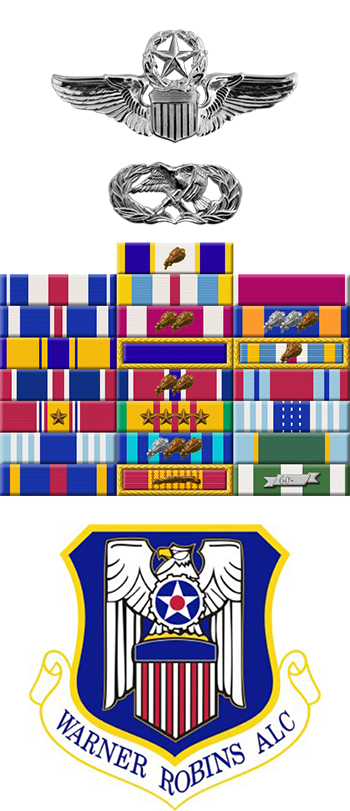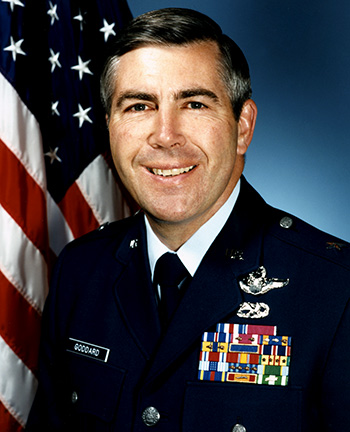
|
Richard N. "Rick" Goddard |
 |
|||
| Rank, Service | ||||
Major General O-8, U.S. Air Force |
||||
| Veteran of: | ||||
|
||||
| Tribute: | ||||
Rick Goddard was born on July 25, 1944, in Utah. He received a Bachelor of Science degree in Political Science from the University of Utah in 1966, and then entered Officer Training School with the U.S. Air Force on September 12, 1966, receiving his commission as a 2d Lt in the U.S. Air Force at Lackland AFB, Texas, on November 25, 1966. Lt Goddard next attended Undergraduate Pilot Training at Vance AFB, Oklahoma, from February 1967 to February 1968, followed by F-100 Super Sabre Combat Crew Training at Luke AFB, Arizona, from February to October 1968. His first assignment was as an F-100 pilot with the 309th Tactical Fighter Squadron at Toy Hoa AB, South Vietnam, from October 1968 to October 1969, and during this time he flew 226 combat missions in Southeast Asia. Capt Goddard next served as a T-37 Tweet Instructor Pilot and Academic Instructor with the 3645th Pilot Training Squadron at Laughlin AFB, Texas, from October 1969 to January 1971, followed by service as an Instructor Pilot in the Standardization and Evaluation Division of the 3646th Pilot Training Wing (redesignated 47th Flying Training Wing in 1972) from January 1971 to March 1973. Capt Goddard served as a Maintenance Officer, Maintenance Supervisor, and then Commander of the 449th Avionics Maintenance Squadron at Kincheloe AFB, Michigan, from April 1973 to October 1975, and he then attended FB-111 Combat Crew Training at Plattsburgh AFB, New York, from October 1975 to January 1976. Major Goddard's next assignment was as an FB-111A Instructor Pilot, Flight Examiner, and Bomber Branch Chief in the Standardization/Evaluation Division with the 715th Bomb Squadron and the 509th Bomb Wing at Pease AFB, New Hampshire, from January 1976 to July 1979, followed by service as B-1 Bomber Systems Acquisition Manager and Chief of the Bomber Branch, Air Vehicle Division with Headquarters Strategic Air Command at Offutt AFB, Nebraskas, from July 1979 to July 1981. Lt Col Goddard served as Commander of the 509th Avionics Maintenance Squadron at Pease AFB from July 1981 to September 1982, and then as Commander of the 393rd Bomb Squadron at Pease from September 1982 to February 1984. Col Goddard served as Chief of the Strategic Aircraft Division with the Directorate of Operational Requirements under the Deputy Chief of Staff for Research, Development, and Acquisition with Headquarters U.S. Air Force in the Pentagon from March 1984 to July 1985, and he then attended the Industrial College of the Armed Forces at Fort Lesley J. McNair in Washington, D.C., from August 1985 to June 1986. His next assignment was as Vice Commander and then Commander of the 380th Bomb Wing at Plattsburgh AFB, New York, from June 1986 to June 1989, followed by service as Assistant Deputy Chief of Staff for Requirements with Headquarters Strategic Air Command at Offutt AFB, Nebraska, from July 1989 to February 1991. Brig Gen Goddard served as Deputy Director for the National Strategic Target List and then Deputy Director for Force Employment Plans on the Joint Strategic Target Planning Staff at Offutt AFB from February 1991 to June 1992, and then as Commander of the 27th Fighter Wing at Cannon AFB, New Mexico, from July 1992 to July 1993. Maj Gen Goddard next served as Director of Logistics with Headquarters U.S. Air Forces in Europe at Ramstein AB, Germany, from July 1993 to January 1995, followed by service as Director of Logistics with Headquarters Air Combat Command at Langley AFB, Virginia, from February 1995 to November 1997. His final assignment was as Commander of Warner Robins Air Logistics Center at Robins AFB, Georgia, from November 1997 until his retirement from the Air Force on March 1, 2000. After his retirement, Gen Goddard served on the Board of Directors of the Georgia Military Coordinating Committee, served as Senior Vice President for Administration, the Vice President, and Chief Technology Officer of Mercer University in Macon, Georgia, and he ran for U.S. Congress in Georgia in 2008. |
||||
|
||||

